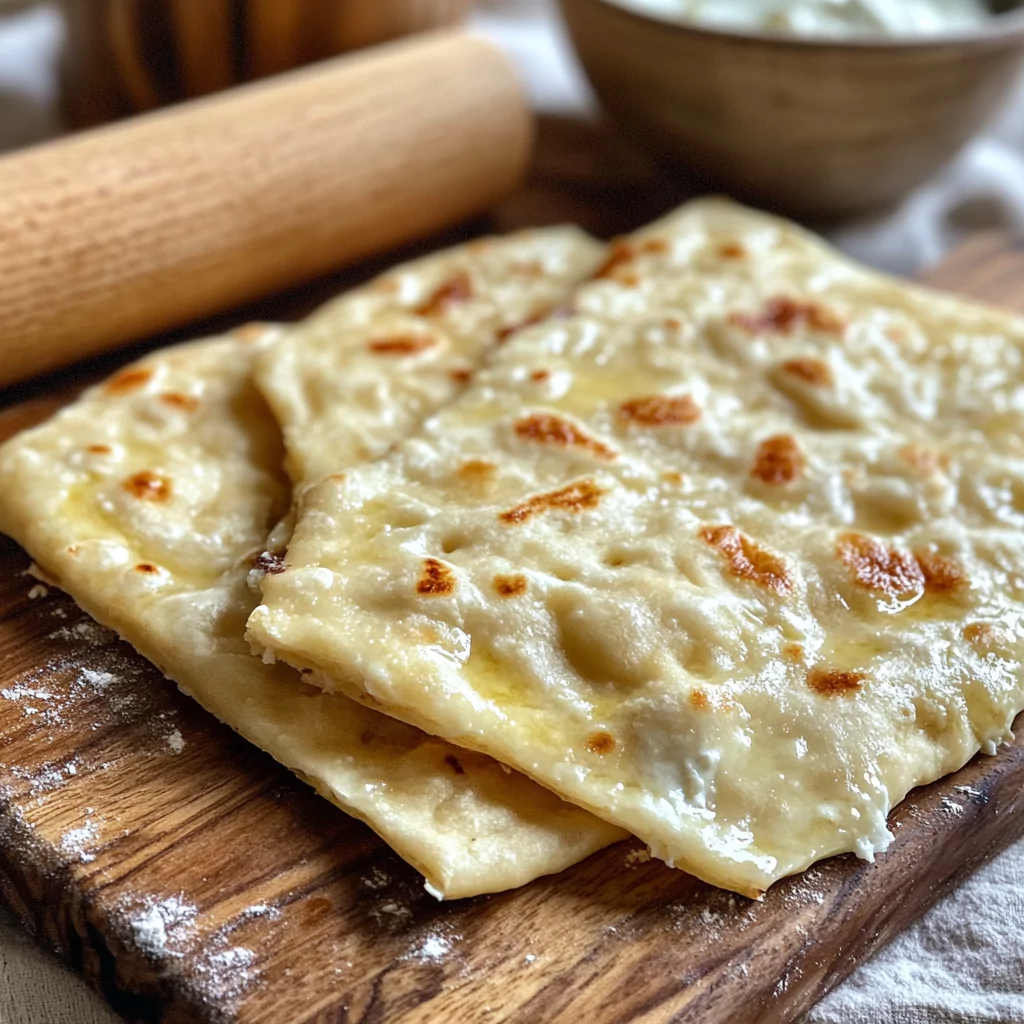Cottage cheese flatbread is a delicious and versatile treat, but many bakers struggle with sogginess that ruins its texture. In this guide, we’ll uncover why soggy cottage cheese flatbread occurs, explore common mistakes, and provide actionable tips for perfect results every time.
What Is Soggy Cottage Cheese Flatbread?
Flatbread made with cottage cheese has a distinct creamy flavor and moist texture. However, achieving the right balance can be tricky. Let’s break down why sogginess is such a common problem and what it means.
Understanding Soggy Cottage Cheese Flatbread
Soggy cottage cheese flatbread occurs when excess moisture from the cottage cheese or improper baking techniques leads to a dense, wet texture. Instead of the airy, fluffy bread you expect, the flatbread turns out sticky and unappetizing.
If you’ve ever wondered, “Why is my flatbread soggy?” the issue usually stems from unbalanced ingredients or incorrect preparation methods.
For tips on ideal flatbread preparation, visit Perfect Cottage Cheese Flatbread.
Why Soggy Cottage Cheese Flatbread Is a Common Problem
The main culprit behind soggy cottage cheese flatbread is excess moisture. Cottage cheese has a high water content, which, if not managed properly, seeps into the dough. Here are some reasons why it’s so common:
- Undrained Cottage Cheese: Failing to remove excess liquid from cottage cheese results in wet dough.
- Improper Ratios: Using too much cheese compared to flour disrupts the consistency of the dough.
- Baking Errors: Insufficient baking time or uneven heat distribution can prevent the bread from cooking through.
What Causes Soggy Cottage Cheese Flatbread?
To understand how to fix soggy flatbread, we first need to identify the causes. “What causes soggy cottage cheese flatbread?” Here’s a detailed look:
The Role of Cottage Cheese Moisture in Soggy Cottage Cheese Flatbread
Cottage cheese is rich in water, which makes it prone to releasing moisture when heated.
- Unstrained Cheese: Cottage cheese straight from the container contains whey, which can add too much liquid to your dough.
- Low-Fat Cottage Cheese: Using low-fat varieties often results in more water content compared to full-fat options, exacerbating sogginess.
Tip: Always drain your cottage cheese using a cheesecloth or fine strainer before adding it to the recipe.
Common Baking Mistakes Leading to Soggy Cottage Cheese Flatbread
Even with properly drained cottage cheese, baking mistakes can contribute to sogginess. Here are the most common errors:
- Underbaking: Not allowing the flatbread to bake long enough traps moisture inside.
- Incorrect Oven Temperature: Baking at a temperature that’s too low doesn’t evaporate the excess moisture.
- Skipping Preheating: Failing to preheat the oven causes uneven cooking, leading to soggy spots.
How to Avoid Soggy Cottage Cheese Flatbread During Preparation
To create the perfect flatbread, preparation is key. Let’s tackle the question, “How do you prevent soggy cottage cheese flatbread?”
Tips for Draining Cottage Cheese to Prevent Soggy Cottage Cheese Flatbread
Properly draining cottage cheese is a crucial step. Here’s how to do it:
- Use a Strainer: Place the cottage cheese in a fine-mesh strainer and press gently to remove excess liquid.
- Cheesecloth Method: Wrap the cottage cheese in a cheesecloth, twist the top, and squeeze out the moisture.
- Refrigerate Overnight: For best results, let the cheese drain in the fridge overnight to ensure dryness.
By removing as much moisture as possible, you set the foundation for a better dough consistency.
Choosing the Right Ingredients to Avoid Soggy Cottage Cheese Flatbread
Ingredient selection plays a pivotal role in achieving non-soggy flatbread. Here’s what to consider:
- High-Protein Flour: Use bread flour or all-purpose flour with a higher protein content to absorb moisture effectively.
- Full-Fat Cottage Cheese: Opt for full-fat versions, as they tend to have less water content compared to low-fat alternatives.
- Complementary Additives: Add dry ingredients like powdered milk or grated parmesan to balance the dough.
For more on ingredient tips, check out Does Cottage Cheese Flatbread Need to Be Refrigerated?
Cooking Techniques to Prevent Soggy Cottage Cheese Flatbread
Once your dough is prepped, proper cooking techniques are essential to avoid sogginess.
Baking Tips for Perfect Cottage Cheese Flatbread Without Sogginess
To achieve fluffy, well-cooked flatbread, follow these baking tips:
- Preheat the Oven: Always preheat your oven to at least 375°F (190°C) to ensure even baking.
- Use a Baking Stone or Steel: These tools help distribute heat evenly and prevent moisture buildup.
- Test for Readiness.: Place a toothpick in the center to check doneness. If it comes out clean, the flatbread is ready.
Why Proper Heat Distribution Prevents Soggy Cottage Cheese Flatbread
One key to preventing sogginess is ensuring proper heat distribution during baking.
- Avoid Overcrowding the Oven: If baking multiple flatbreads, leave enough space for air circulation.
- Adjust Racks: Place your baking sheet in the middle rack for optimal heat exposure.
If sogginess still persists, learn more from related baking fixes at Why Does My Cottage Cheese Flatbread Burn?

Fixing Soggy Cottage Cheese Flatbread: Quick Solutions
Mistakes can happen, and sometimes you’re left with soggy cottage cheese flatbread despite your best efforts. Don’t worry—there are ways to salvage it. This section provides actionable tips for saving soggy cottage cheese flatbread after baking and transforming it into delicious alternatives.
How to Save Soggy Cottage Cheese Flatbread After Baking
When your flatbread turns out soggy, you can often fix it with these simple methods:
- Rebake at a Higher Temperature: Place the flatbread back in the oven at 400°F (204°C) for 5–10 minutes. This helps evaporate excess moisture and creates a crispier texture.
- Use a Skillet: Heat a non-stick skillet on medium heat and place the flatbread inside. Press it down gently with a spatula to expel trapped moisture while crisping the outer layer.
- Slice and Toast: Cut the flatbread into smaller pieces and toast them in an oven or toaster oven until they firm up.
These methods work best for mildly soggy cottage cheese flatbread that hasn’t been heavily compromised.
Transforming Soggy Cottage Cheese Flatbread into Other Dishes
If the flatbread remains too soggy, consider repurposing it into new dishes instead of throwing it away:
- Flatbread Croutons: Slice the soggy cottage cheese flatbread into cubes, drizzle with olive oil, and bake until crisp. These make excellent additions to soups or salads.
- Savory Bread Pudding: Tear the flatbread into pieces, layer it in a baking dish, and pour a mixture of eggs, milk, and cheese over it. Bake until golden and set for a comforting dish.
- Flatbread Chips: Cut the flatbread into triangles, season with spices, and bake until crunchy. Serve with dips like hummus or tzatziki.
For more ideas, check out Perfect Cottage Cheese Flatbread.
Recipe Variations to Avoid Soggy Cottage Cheese Flatbread
Adapting your recipe can significantly reduce the chances of ending up with soggy cottage cheese flatbread. Here are two exciting variations designed to minimize moisture and improve texture.
Herb and Garlic Cottage Cheese Flatbread Without Sogginess
Adding herbs and garlic not only enhances flavor but also absorbs some of the moisture in the dough.
Ingredients:
- 1 cup cottage cheese (drained)
- 2 cups all-purpose flour
- 1/2 tsp baking powder
- 2 cloves garlic (minced)
- 1 tbsp dried herbs (e.g., rosemary or thyme)
- Salt and pepper to taste
Instructions:
- Drain the cottage cheese thoroughly to remove excess moisture.
- In a bowl, combine flour, baking powder, garlic, herbs, salt, and pepper. Mix in the drained cottage cheese until a soft dough forms.
- Roll out the dough, bake at 375°F (190°C) for 20–25 minutes, and enjoy perfectly balanced herb and garlic flatbread.
Gluten-Free Cottage Cheese Flatbread That Stays Firm
For those on a gluten-free diet, soggy cottage cheese flatbread can be a common challenge. This recipe uses gluten-free flour for a firmer texture.
Ingredients:
- 1 cup cottage cheese (drained)
- 1 1/2 cups gluten-free all-purpose flour
- 1/4 cup almond flour
- 1 tsp xanthan gum (for structure)
- Salt to taste
Instructions:
- Combine all ingredients in a mixing bowl and knead into a dough.
- Roll out the dough to your desired thickness and bake at 400°F (204°C) for 18–22 minutes.
This recipe ensures you get a sturdy yet flavorful flatbread that holds its shape.
Toppings That Complement Soggy Cottage Cheese Flatbread
Toppings play a significant role in determining the final texture of your flatbread. Let’s explore how to select toppings that work well with cottage cheese flatbread while reducing sogginess.
How to Select Toppings That Reduce Moisture in Soggy Cottage Cheese Flatbread
- Avoid High-Moisture Ingredients: Skip watery toppings like fresh tomatoes or wet mozzarella. Instead, opt for roasted vegetables or dry cheeses like feta.
- Pre-Cook Ingredients: If you’re adding mushrooms or spinach, sauté them beforehand to remove their water content.
- Use a Protective Layer: Spread a thin layer of olive oil or ricotta cheese on the base to create a barrier against moisture.
Best Pairings to Complement Soggy Cottage Cheese Flatbread
Even when sogginess strikes, the right toppings can improve the taste and presentation:
- Caramelized Onions and Goat Cheese: The sweetness of caramelized onions pairs beautifully with tangy goat cheese, enhancing the flatbread’s flavor.
- Roasted Bell Peppers and Pesto: These toppings bring vibrant colors and bold flavors while keeping the flatbread dry.
- Grilled Chicken and Arugula: Adding protein and fresh greens creates a balanced meal without overwhelming moisture.
Learn more about pairing ideas in Does Cottage Cheese Flatbread Need to Be Refrigerated?
Dietary Adjustments for Soggy Cottage Cheese Flatbread
Whether you’re following a keto diet or aiming for low-calorie options, there are specific adjustments you can make to improve your cottage cheese flatbread.
Keto-Friendly Options for Cottage Cheese Flatbread Without the Sogginess
For those on a keto diet, keeping carbs low and texture intact is essential. Here’s how to modify your recipe:
- Replace Flour: Use almond flour or coconut flour instead of traditional flour to lower the carb count.
- Add Binding Agents: Incorporate psyllium husk or xanthan gum to maintain structure without relying on starches.
- Cheese Variety: Opt for dry-aged cheeses like parmesan to absorb moisture while enhancing the flavor.
Low-Calorie Ideas to Prevent Soggy Cottage Cheese Flatbread
If you’re watching your calorie intake, try these adjustments:
- Use Low-Fat Cottage Cheese: While it contains more water, proper draining can offset the moisture without adding calories.
- Increase Veggie Content: Mix in finely grated zucchini or carrots to add bulk without significantly increasing calories.
- Skip Oil-Based Toppings: Avoid high-calorie toppings like extra cheese or oils. Stick to fresh herbs and lean proteins.
For more low-calorie cooking ideas, check out Why Does My Cottage Cheese Flatbread Burn?

Common Mistakes Leading to Soggy Cottage Cheese Flatbread
Creating the perfect flatbread takes precision, and small errors can easily lead to soggy cottage cheese flatbread. Identifying these mistakes is the first step toward avoiding them.
Overloading Ingredients That Result in Soggy Cottage Cheese Flatbread
One of the most common mistakes is adding too many wet ingredients to the dough. Here’s why it happens and how to prevent it:
- Excess Cottage Cheese: Using more than the recipe requires can overwhelm the flour, leaving too much moisture in the dough.
- Overloading Toppings: Adding high-moisture toppings like fresh tomatoes, mushrooms, or spinach without cooking them first can release water during baking, making the flatbread soggy.
- Insufficient Dry Ingredients: Failing to balance wet ingredients with enough flour, breadcrumbs, or dry seasonings results in a dough that’s too wet to hold its shape.
Tip: Stick to recipe measurements and always pre-cook or pat dry any toppings with high water content.
Ignoring Cooking Time and Its Impact on Soggy Cottage Cheese Flatbread
Even if the dough is perfectly prepared, improper cooking can still lead to soggy results.
- Underbaking: Cutting the baking time short doesn’t allow enough time for excess moisture to evaporate.
- Uneven Heat: If your oven has hot and cold spots, parts of the flatbread may remain uncooked and soggy.
- Skipping Preheating: Baking in an unheated oven leads to inconsistent cooking, increasing the risk of soggy flatbread.
Solution: Always preheat the oven to the recommended temperature and bake the flatbread for the full suggested time. Use an oven thermometer to monitor heat distribution.
Homemade Recipe: Perfect Cottage Cheese Flatbread Without Sogginess
Achieving flawless flatbread doesn’t have to be complicated. This step-by-step recipe ensures you’ll never end up with soggy cottage cheese flatbread again.
Step-by-Step Guide to Make Soggy Cottage Cheese Flatbread a Thing of the Past
Ingredients:
- 1 cup full-fat cottage cheese (drained)
- 2 cups all-purpose flour
- 1 tsp baking powder
- 1/4 tsp salt
- 1 tbsp olive oil
Instructions:
- Drain the Cottage Cheese: Use a cheesecloth or strainer to remove excess moisture from the cottage cheese. This step is crucial to avoid soggy cottage cheese flatbread.
- Mix Dry Ingredients: Combine flour, baking powder, and salt in a mixing bowl.
- Combine Wet Ingredients: Add the drained cottage cheese and olive oil to the dry mixture. Mix until a dough forms.
- Knead the Dough: Transfer the dough to a floured surface and knead gently for 5 minutes.
- Shape the Flatbread: Roll out the dough to your desired thickness. For crispier flatbread, aim for a thinner layer.
- Bake: Preheat your oven to 400°F (204°C). Place the flatbread on a parchment-lined baking sheet and bake for 18–20 minutes or until golden brown.
Modifications to Ensure a Crispy and Flavorful Flatbread
You can customize this recipe to suit your preferences while ensuring a non-soggy result:
- Add Dry Herbs: Incorporate dried rosemary or thyme for extra flavor without adding moisture.
- Swap Flour: Experiment with whole wheat flour or a gluten-free blend for a healthier twist.
- Brush with Oil: Before baking, lightly brush the dough with olive oil to create a protective barrier against sogginess.
For more recipe inspiration, check out Perfect Cottage Cheese Flatbread.
Storing and Reheating Soggy Cottage Cheese Flatbread
Proper storage and reheating techniques are essential to maintaining the texture and flavor of your flatbread. If not handled correctly, even the best flatbread can become soggy.
Best Practices to Store Cottage Cheese Flatbread Without Causing Sogginess
- Cool Completely: Allow the flatbread to cool to room temperature before storing it. Warm bread creates condensation, which leads to sogginess.
- Wrap it Right: Wrap the flatbread tightly in aluminum foil or plastic wrap to keep it fresh.
- Use Airtight Containers: Store the wrapped flatbread in an airtight container to prevent moisture from seeping in.
- Refrigerate or Freeze:
- In the refrigerator: Store for up to 3 days.
- In the freezer: Wrap each flatbread individually and freeze for up to 3 months.
For more storage tips, visit Does Cottage Cheese Flatbread Need to Be Refrigerated?
How to Reheat Soggy Cottage Cheese Flatbread While Retaining Texture
Reheating soggy cottage cheese flatbread can be tricky, but these tips will help:
- Oven Method: Preheat the oven to 350°F (177°C). Place the flatbread directly on the rack or on a baking sheet to crisp it up. Heat for 8–10 minutes.
- Skillet Method: Heat a non-stick skillet over medium heat and reheat the flatbread for 3–5 minutes per side. This method restores the crispy texture effectively.
- Avoid Microwaving: Microwaving tends to make flatbread soggier, so it’s best to stick to dry heat methods.
FAQs About Soggy Cottage Cheese Flatbread
This FAQ section addresses common questions about soggy cottage cheese flatbread to help you troubleshoot and improve your baking process.
Why Does My Cottage Cheese Flatbread Turn Soggy?
Soggy cottage cheese flatbread often results from excess moisture in the dough or improper baking techniques. The most common causes include:
- Using undrained cottage cheese
- Baking at too low a temperature
- Adding too many high-moisture toppings
Solution: Always drain the cottage cheese thoroughly and follow the baking tips outlined earlier in this guide.
Can I Fix Soggy Cottage Cheese Flatbread After Cooking?
Yes, you can fix soggy cottage cheese flatbread by rebaking or repurposing it.
- Rebake: Place it back in the oven at 400°F (204°C) for 5–10 minutes.
- Repurpose: Transform it into croutons, chips, or a bread pudding for a creative twist.
What Are the Best Substitutes for Cottage Cheese in Flatbread Recipes?
If you’re looking for alternatives to cottage cheese, consider these options:
- Ricotta Cheese: Offers a similar texture but with less moisture.
- Greek Yogurt: Works well as a binding agent while adding creaminess.
- Mashed Potatoes: A unique option that creates a soft yet firm texture.
For more ideas on baking substitutions, check out related tips in Perfect Cottage Cheese Flatbread.
Conclusion
Soggy cottage cheese flatbread doesn’t have to be a persistent problem. By understanding the common mistakes, following foolproof recipes, and applying proper storage and reheating techniques, you can enjoy perfectly crisp and flavorful flatbread every time. Whether you’re troubleshooting sogginess, trying new recipe variations, or exploring topping combinations, this guide has everything you need for success.
For additional tips and expert recipes, visit Bon Appétit’s recipe collection to refine your cooking techniques and discover new flatbread ideas.


4 thoughts on “How To Prevent Soggy Cottage Cheese Flatbread?”